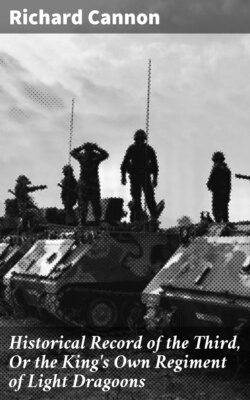Читать книгу Historical Record of the Third, Or the King's Own Regiment of Light Dragoons - Cannon Richard - Страница 10
На сайте Литреса книга снята с продажи.
Embodied in 1781.
ОглавлениеTwenty-third—by Lieut.-General Sir John Burgoyne, Baronet, for service in India, and was numbered the Nineteenth after the peace in 1783. This regiment signalized itself on numerous occasions in India, and was rewarded with the honour of bearing on its guidons and appointments the Elephant, with the words Assaye and Seringapatam. The word Niagara was also added in commemoration of the gallantry of two troops, in the year 1813, in North America. In 1817 it was constituted a corps of Lancers. It was disbanded in Ireland in 1821.
Thus a few years had produced a great change in the British Army. Twenty-five years previously to the termination of the American war there was not a single Light Dragoon Regiment in the Service, and in 1783 there were seventeen; four of them were disbanded at that period, and thirteen retained in the Service.
Soon after the termination of the American war, the French monarch having, by aiding the rebellious British provincials, taught his own subjects a lesson of insubordination, was deprived of the reins of government; and the violent conduct of the French revolutionists in the West Indies occasioned the Twentieth or Jamaica Regiment of Light Dragoons to be raised in 1791 by Colonel Henry F. Gardner, for service in that island. Besides its services in Jamaica, detachments of this regiment served at Malta; Sicily; at the taking of the Cape of Good Hope, in 1806; at the capture of Alexandria, in 1807; at the attack on Monte Video; in Portugal; at Genoa; and on the eastern coast of Spain; and acquired the honour of bearing the word Peninsula on its guidons and appointments. It was disbanded in Ireland in 1818.
War with France commenced in 1793, and was followed by augmentations to the Army. It was not found necessary to add a single Heavy Cavalry Regiment; but the following Regiments of
